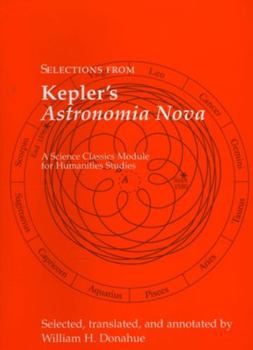Selections from Kepler's Astronomia Nova
Select Format
Select Condition 
Book Overview
Johannes Kepler wrote Astronomia Nova (1609) in a singleminded drive to sweep away the ancient and medieval clutter of spheres and orbs and to establish a new truth in astronomy, based on physical causality. Thus a good part of the book is given over to a nontechnical discussion of how planets can be made to move through space by physical forces. This is the theme of the readings in the present module. The selection includes Kepler's Introduction...
Format:Paperback
Language:English
ISBN:1888009284
ISBN13:9781888009286
Release Date:March 2005
Publisher:Green Lion Press
Length:120 Pages
Weight:0.55 lbs.
Dimensions:0.4" x 6.9" x 9.9"
Customer Reviews
3 ratings
Excellent Introduction
Published by Thriftbooks.com User , 15 years ago
This is an excellent introduction to Kepler for people not confident in their ability to breeze through the more complex mathematical arguments of his "celestial physics." Kepler's own introduction is enough to enthrall any reader of history/philosophy of science. Anyone who has some geometry and ancient astronomy under their belts will see that he's a stunning mathematician. Even for this edition of selections, I advise having some familiarity with Euclid and Ptolemy. General familiarity (from Wikipedia, even) of Copernicus and Brahe would be very helpful to understand what he's arguing against. I suppose it would be possible to pick this up and read it without any of this other stuff, but I personally would've been lost without the undergirding of first year-and-a-half of the mathematics program at St. John's College. After reading this I quickly put Kepler at the top of my "Must Read More" list. The editors and translator are very helpful and accommodating. I recommend this to any mathematics/physics-lover looking for an introduction to Kepler's world.
Great for lovers of the history of science
Published by Thriftbooks.com User , 16 years ago
I love using this as one of my required texts for the History and Philosophy of Science course I teach. It's great at introducing Kepler's work to first time readers and it also has primary sections from his work. What's best is that you can guide your students through these prime selections without having to lose them in mathematics. And if you are so inclined, and it's worth the try, there are some problems you can tackle and you only need a limited amount of geometry. I also recommend it if you're just into the history of science.
Wonderful
Published by Thriftbooks.com User , 16 years ago
"My aim in the present work is chiefly to reform astronomical theory ... so that what we compute from the tables may correspond to the celestial phenomena. ... Meanwhile, although I place this goal first and pursue it cheerfully, I also ... inquire into celestial physics and the natural causes of the motions. ... Indeed, all things are so interconnected, involved, and intertwined with one another that after trying many different approaches to the reform of astronomical calculations ... none other could succeed than the one founded upon the motions physical causes themselves, which I establish in this work." (Introduction, pp. 4-5). A decisive step towards this new physical theory is Kepler's proof in chapter 24 that the earth requires an equant, i.e. that the point with respect to which it moves uniformly is not the center of the orbital circle but rather a point close to it. The old theory, without the equant, had worked well for Ptolemy (sun instead of the earth, of course) and Copernicus, since it predicts the angular position very accurately. But Kepler shows that it fails to predict the distance between the earth and the sun. This distance at different times can be determined by observing the sun and Mars at times 687 days apart; this is the period of Mars, so we get a simple trigonometric calculation with both Mars and the sun as fixed points. Thus the earth now has an equant just as the outer planets did for Ptolemy and Copernicus. "Further, there is nothing to prevent our believing the same of Venus and Mercury. Indeed, I now have a proof that this is the origin of the belief that the centers of these planets' eccentrics move around on a small annual circle. Therefore all planets have this [eccentric circle with an equant]." (Chapter 32, p. 52). So the equant is no longer just some trick but in fact a universal principle, so we feel that it must have a deeper explanation. The key observation is that the equant (with bisected eccentricity) makes the planet's speed inversely proportional to its distance from the sun (chapter 32). This suggests that "the power that moves the planets resides in the body of the sun" (chapter 33). Kepler thinks we should pretty much have seen this coming, considering the "worthiness of eminence of the sun" and the fact that "the source of the world's life ... is the same as the source of the light which forms the adornment of the entire machine, and which is also the source of the heat by which everything grows" (pp. 57-58). Indeed, the motive power's "very close kinship with light" is confirmed by its linear deterioration with distance, since it spreads over the circumference of a circle so to speak (p. 59). Of course one might argue that since light, and perhaps also the motive power, spreads in three dimensions, i.e. over the surface of a sphere, it should obey an inverse square law, but Kepler has already made up his mind on the linear law---"And this is true, both of the steelyard or lever, and of the moti





